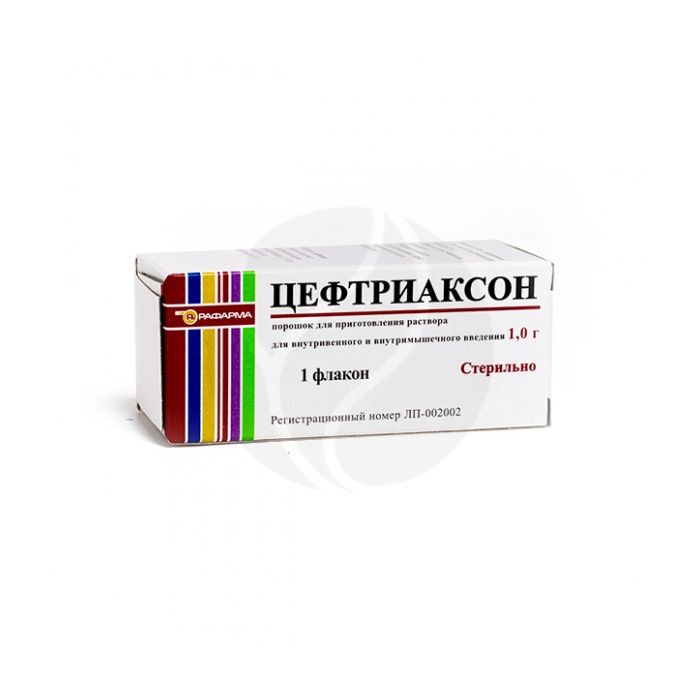Ceftriaxone powder for prig. solution for intravenous and intramuscular administration 1g, No. 1
Expiration Date: 05/2027
Russian Pharmacy name:
Цефтриаксон порошок д/приг. р-ра д/в/в и в/м введения 1г, №1
Infectious and inflammatory diseases caused by microorganisms sensitive to ceftriaxone, incl.
peritonitis, sepsis, meningitis, cholangitis, empyema of the gallbladder, shigellosis, salmonella, pneumonia, lung abscess, empyema of the pleura, pyelonephritis, infections of bones, joints, skin and soft tissues, genitals, infected wounds and burns.
Prevention of postoperative infection.
Individual.
Injected intramuscularly or intravenously, 1-2 g every 24 hours or 0.5-1 g every 12 hours. Depending on the etiology of the disease, you can use intramuscularly at a dose of 250 mg once.
The daily dose for newborns is 20-50 mg / kg; for children aged 2 months to 12 years - 20-100 mg / kg; the frequency of administration is 1 time / day.
The duration of the course is determined individually.
In patients with impaired renal function, correction of the dosage regimen is required taking into account the CC values.
Maximum daily doses: for adults - 4 g, for children - 2 g.
Powder for preparing a solution for intravenous and intramuscular administration is crystalline, almost white or yellowish in color.
1 fl.
ceftriaxone (sodium salt form)
Hypersensitivity to ceftriaxone and other cephalosporins.
pharmachologic effect
A cephalosporin antibiotic of the third generation with a broad spectrum of action. It has a bactericidal effect by inhibiting the synthesis of the bacterial cell wall. Ceftriaxone acetylates membrane-bound transpeptidases, thus disrupting the cross-linking of peptidoglycans, which is necessary to ensure the strength and rigidity of the cell wall. Active against aerobic, anaerobic, gram-positive and gram-negative bacteria. It is resistant to the action of ?-lactamases.
Pharmacokinetics
Plasma protein binding is 85-95%. Ceftriaxone is widely distributed into tissues and body fluids. Therapeutic concentrations are achieved in the cerebrospinal fluid in meningitis. High concentrations are achieved in bile. Penetrates through the placental barrier, excreted in breast milk in small quantities. About 40-65% of ceftriaxone is excreted unchanged in the urine. The rest is excreted in bile and feces.
Side effect
From the digestive system: nausea, vomiting, diarrhea, a transient increase in the activity of hepatic transaminases, cholestatic jaundice, hepatitis, pseudomembranous colitis.
Allergic reactions: skin rash, itching, eosinophilia; rarely - Quincke's edema.
From the side of the hematopoietic system: with prolonged use in high doses, changes in the picture of peripheral blood (leukopenia, neutropenia, thrombocytopenia, hemolytic anemia) are possible.
From the side of the blood coagulation system: hypoprothrombinemia.
From the urinary system: interstitial nephritis.
Effects due to chemotherapeutic action: candidiasis.
Local reactions: phlebitis (with intravenous injection), soreness at the injection site (with intramuscular injection).
Application during pregnancy and lactation
There are no adequate and well-controlled studies on the safety of ceftriaxone during pregnancy. The use of ceftriaxone during pregnancy and lactation is possible in cases where the expected benefit of therapy to the mother outweighs the potential risk to the fetus. Ceftriaxone is excreted in breast milk in low concentrations. In experimental studies on animals, no teratogenic and embryotoxic effects of ceftriaxone were found.
Application for impaired renal function
In patients with impaired renal function, correction of the dosage regimen is required taking into account the CC values. Use with caution in severe renal impairment.
Application in children
In newborns with hyperbilirubinemia, especially in premature infants, it is possible to use it under strict medical supervision.
special instructions
In patients with hypersensitivity to penicillins, allergic reactions to cephalosporin antibiotics are possible. Use with caution in severe renal impairment. Ceftriaxone solutions should not be mixed or administered concurrently with other antimicrobial drugs or solutions. In newborns with hyperbilirubinemia, especially in premature infants, it is possible to use it under strict medical supervision.
Drug interactions
Ceftriaxone, suppressing the intestinal flora, interferes with the synthesis of vitamin K. Therefore, when used simultaneously with drugs that reduce platelet aggregation (NSAIDs, salicylates, sulfinpyrazone), the risk of bleeding increases. For the same reason, with simultaneous use with anticoagulants, an increase in the anticoagulant effect is noted. With simultaneous use with 'loop' diuretics, the risk of developing nephrotoxic effects increases.

